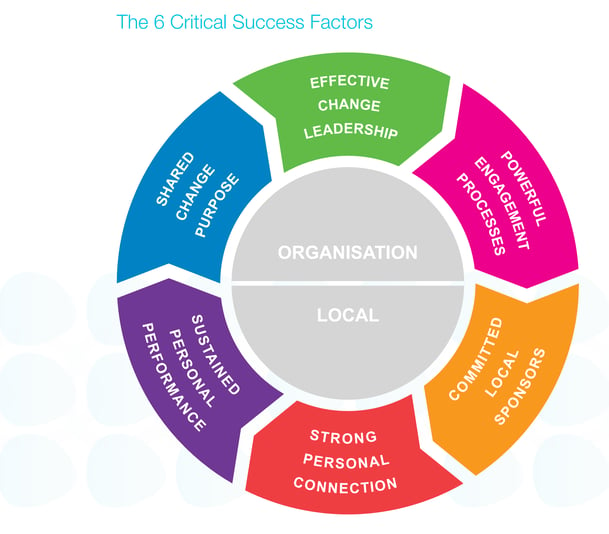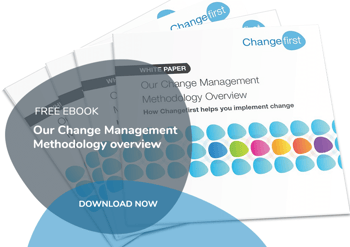Without proven Change Management processes, it is very difficult to consistently achieve the organization’s change goals.

We’ve previously talked about the value gap that is created between project delivery and true benefits realisation on a change project. The reason the difference between the two is called a “value gap” is because there is a difference between the value that’s achieved at delivery and the business case or return on investment that was initially predicted. And it is this value gap that is the most powerful case for Change Management and developing a change capability in every organization.
Connecting organizational and individual change is key
To ensure successful change implementation it is imperative that you create synergy and connectivity between your organizational transitional process and the individual’s personal change process. In other words, you need to match what your company needs with what the people in your company can potentially accomplish. Change can be strategized in the executive team boardroom – but unless someone or a team of people cascade that change strategy out to the organization and its divisions, it will make no difference to people in a factory or in a country or in a plant somewhere. And if it makes no difference to them, then it makes no difference to the organization or its balance sheet.
As part of Changefirst’s People Centred Implementation (PCI®) methodology we understand how important it is for organizational and local change to mesh. Our PCI methodology outlines six critical success factors that will help you to ensure that they do. Three are organizational success factors and three are local success factors, and together they facilitate the implementation of effective change that sticks.
6 Critical Success Factors for success
Here is an overview of the six critical success factors (CSFs). It is important to remember that each of these factors describes a desired outcome. So, for example, CSF 1: Shared Change Purpose is what should be happening in the organization if you are successful. Everyone will know about the purpose of the change because you will have shared it successfully.

CSF1: Shared Change Purpose
You want to create and share a powerful case for change in the organization. Your hope is that this achieves more than awareness and that it creates some energy and buzz but, at a minimum, you must achieve clarity – certainly in the people who will need to adapt to the changes. You want people to understand why the change is needed.
CSF 2: Effective Change Leadership
You want change leaders to provide direction, guidance and support for the change. They need to provide this to the people adapting to and implementing the change. Done well, this allows people to see their leaders demonstrating their own commitment to the change through their actions as well as their words.
CSF 3: Powerful Engagement Process
You need powerful engagement processes to put in place which actively engage the organization in the change process. These engagement processes are designed to foster commitment, encourage new behavior and teach new skills. Done well, they offer a framework that builds commitment and helps people to undertake the actions they need to do to make the change successful.
CSF 4: Committed Local Sponsors
You need to enable middle and front-line managers to take responsibility for the change in their area of authority. Firstly, they need to commit to the change themselves and demonstrate that commitment. Then they need to lead their change. Done well, this will connect the need for organizational change to the reality of what that means to the people having to change.
CSF 5: Strong Personal Connection
You need to help people to develop a strong personal connection as this builds personal commitment to the change. This can be done, for example, by helping people see how they can be more successful when working in new ways. Done well, this helps people commit to the change sooner and adapt their new behavior more quickly.
CSF 6: Sustained Personal Performance
This is the point at which people’s concerns and reactions to the change challenge are effectively addressed. You need to ensure that those involved with the change are helped and supported through the transition process and that their behavior adapts. Done well, this ensures that people move through the transition stage swiftly so that performance is not adversely affected and/or is maintained during the change process.
Change is not sequential - adapt your approach to suit
Although this is a six-staged model, it is not necessarily sequential. It doesn’t have to be implemented “one through six”, although that is the most common way to describe the stages. For example, as a change agent you may decide that you need to get more leaders on board or establish if there is any senior support for the change (CSF2) prior to creating a shared change purpose (CSF1). For instance, when I was a corporate change agent I would test the early support for any change by informally locating influential managers in the organization and gauging their support for the proposed initiative. If support was low, I would consider slowing the process of change until that support could be gathered or I would find ways to get key people to help me craft a different solution. In situations such as this there is no point creating a shared vision if there is no support for it. It would be a waste of time and resources. Once you become more familiar with the model you will be able to decide the most appropriate starting point for your change.
We understand that in order to be a successful change agent you need a set of comprehensive set of skills, processes and tools at your disposal. We hope you find this information helpful going forward with your next change initiative.
|
|
DOWNLOAD OUR WHITE PAPER Methodology and a structured approach to change are key for success. Find out how our 6 proven, research-based Critical Success Factors can help you deliver strategic change more effectively in your organization. Download a copy of our white paper now. |




Leave a comment